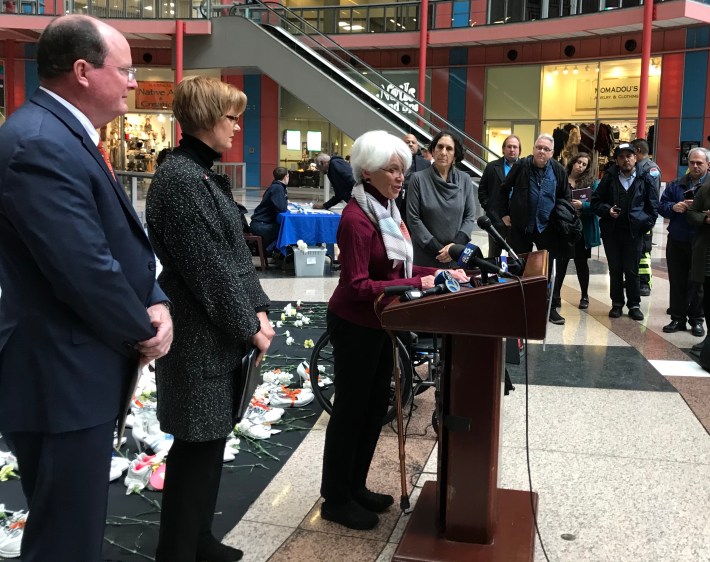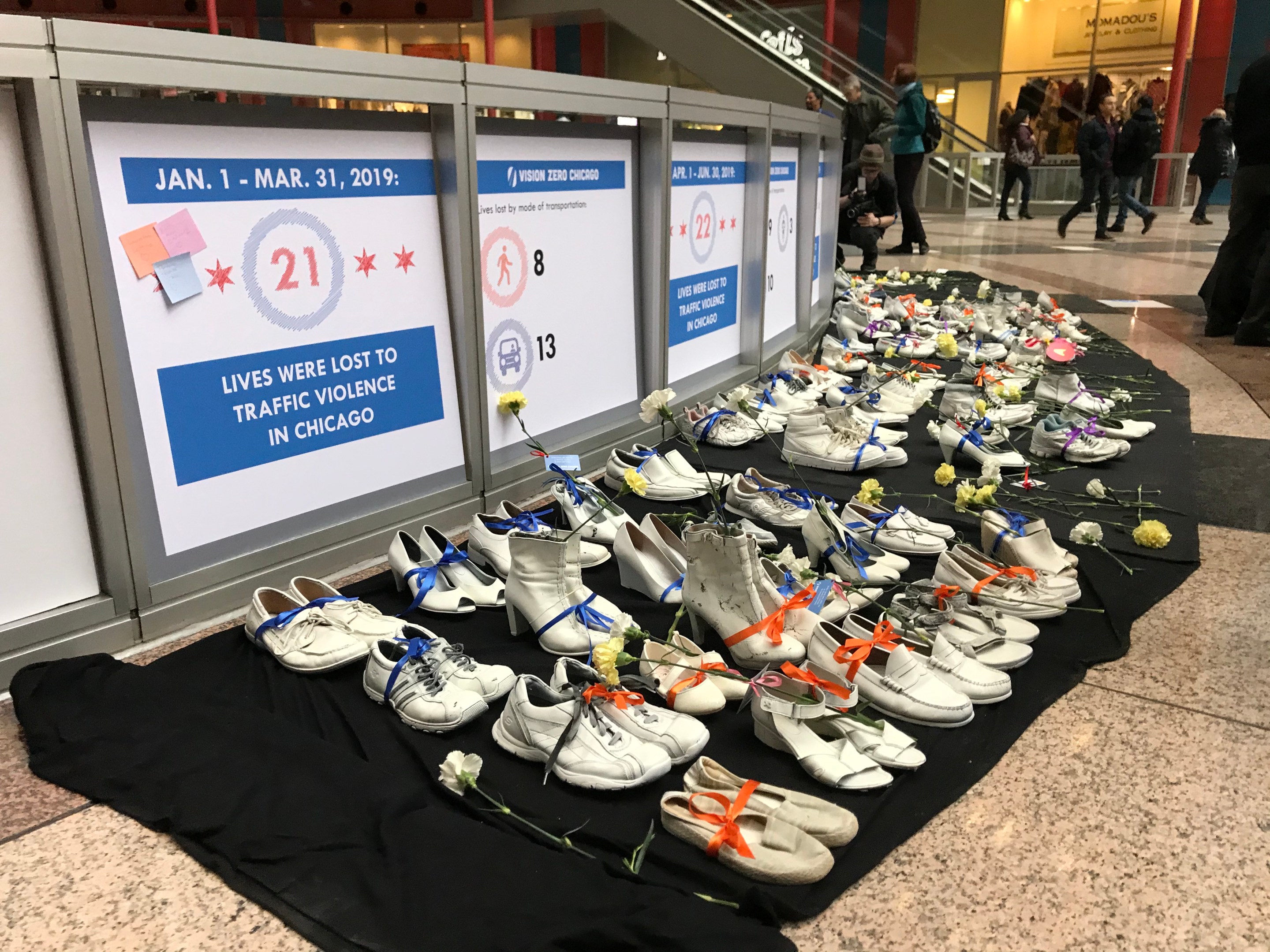Dozens of people gathered in the atrium of Chicago's James R. Thompson this morning to remember the 77 people lost to traffic violence on Chicago streets so far this year. As part of the global commemoration of World Day of Remembrance for Road Traffic Victims, the city's Vision Zero Chicago crash prevention program had placed 77 pairs of white shoes representing the victims. Signs hung by the footwear noted how many people were killed each quarter, and which modes they were using at the time, walking, biking, driving, or motorcycle.
During the press conference, city and state officials, traffic safety advocates, and crash survivors discussed what needs to be done to prevent serious and fatal crashes. "This event serves as a reminder of what everybody here already knows," said Chicago Department of Transportation acting commissioner Tom Carney. "Serious traffic crashes cannot be the cost of doing business. These are traumatic events that impact individuals, families, and communities." He said a videographer would be interviewing attendees about how traffic tragedies have their lives.
May Anderson, the Chicago director of the American Association of Retired Persons noted that older adults make up a significant percentage of pedestrian deaths. One-fifth of people 65 and older do not drive. Yet about half of respondents to an AARP survey said they can not walk safely on the streets in their neighborhoods. "Let us all use the emotion of this day to motivate us to create policies, designate infrastructure, and change the mindset so that Chicago residents are safe when they walk outside their doors."
Next, crash survivor Phyllis Mitzen, president of Skyline Village, an association of residents near North Michigan Avenue, who had come to the event by wheelchair, discussed nearly losing her life to a negligent driver near her home. "It is sobering to see the shoes here and to think that one of the pairs could have been mine."
On an afternoon last June, Mitzen was walking home at Delaware Place and Michigan, crossing with a walk signal in a crosswalk. "Suddenly I was struck and knocked to the street," she said. "I watched with horror as a large, white Mercedes delivery truck rolled forward and its right front tire stopped squarely on my left leg and ankle." She visualized her right leg being crushed as well and wondered if she would lose her legs or her life. "Thank goodness, after what seems like an eternity, the driver put the truck in reverse, revealing my pulverized leg."

She underwent two surgeries totaling 16 hours, spending four days in the ICU, six days in the hospital, and almost three months in a nursing home rehab facility, followed by outpatient physical therapy, which she's still undergoing.
Mitzen noted that Michigan between Oak and Chicago Avenue, the stretch where the driver struck her, is the city's third-highest crash corridor. She added that the city's 2005-2009 pedestrian crash analysis found that 75 percent of all pedestrian crashes occur at or near intersections; 66 percent involve turning vehicles at stoplights; 48 percent of the collisions involve failure to yield to a pedestrian; 56 percent occurred while pedestrians were in the crosswalk, and in 60 percent of the cases the victim had a green light. All of those factors applied to her case.
Skyline Village is asking the city to lengthen the pedestrian crossing times on Michigan between Oak and Chicago. They'll be holding a pedestrians safety town hall meeting with state rep Lamont Robinson on February 28, 5:30 p.m. Email info@skylinevillagechicago.org for details. "I don't want what happened to me to happen to anyone else, ever," Mitzen said.
Donna Peace, who works for the Chicago Department of Health, but was speaking as a citizen, shared the story of how in 2011 her youthful 91-year-old mother Frances was fatally struck by a driver in New York City while running errands. Like Mitzen, she was crossing the street in a crosswalk with a walk signal when a turning motorist failed to yield. The driver, who was making a left turn in an SUV, knocked the senior over, causing her to hit her head on the pavement, and she died hours later from brain injuries.
Peace said that she has since realized that she could have easily made the same mistake herself when driving. She noted that even if you follow traffic laws and don't use your phone while driving, it's easy to get distracted, "and then you're making a turn and suddenly there's somebody there. Every time that happens my heart beats a little faster, and I resolve to drive more mindfully."
"Any one of us getting in a car needs to remember that the bicyclist, the kid on the skateboard or the scooter, the person on a motorcycle, the pedestrian, might well be us or someone we know, and even if they aren't, someone loves or knows that person" Peace concluded. "So we just need to be mindful. Driving is the most dangerous thing that any one of us can do."
The Active Transportation Alliance's Chicago advocacy manager Julia Gerasimenko noted that Black Chicagoans are more than twice as likely to be killed in a traffic crash than white residents, and almost half of all fatal Chicago crash victims are African American. I'd note that one factors behind this discrepancy is wide street layouts on the South and West sides that encourage speeding and make walking and biking less safe, due to car-centric 20th Century urban planning policies that disproportionately impacted communities of color.
During a Q & A with Tom Carney after the speeches, I noted that a few years ago CDOT proposed protected bike lanes on Stony Island Avenue, where a driver struck and killed cyclist Lee Louellen, 40, early Sunday morning. Luster Jackson, 58, was killed on his bike a few blocks away on Stony Island in July 2018. Local aldermen Lesley Hairston and Michelle Harris vetoed the bike lanes.
Immediately after Mayor Lori Lightfoot took office, she signed an executive order that supposedly ended the practice of aldermen having the power to kill projects in their wards, called aldermanic prerogative. I asked Carney how that's affecting CDOT protocol.
"Aldermanic input is one of a variety of factors" influencing infrastructure project decisions, Carney responded. "We have to work with the alderman because they do provide valuable input... it's not the only factor though. We do intend to continue to work with aldermen, to work with the community, because we want something that works for all."
Has anything changed in the way CDOT does business since Lightfoot signed the executive order? "Not regarding the infrastructure that we do, no."
So, despite the recent deaths of two cyclists on the high-speed multilane street, it looks like the bike lanes probably aren't going to built anytime soon unless citizens apply some political pressure. That would force the city to put its money where its mouth is when it comes to Vision Zero.






